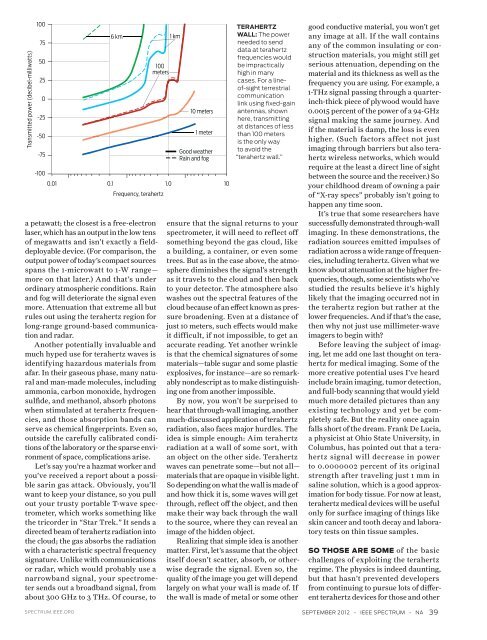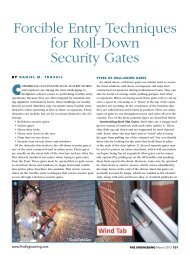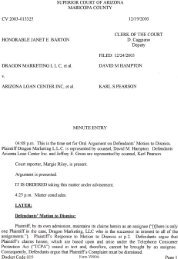The Truth About Terahertz
The Truth About Terahertz
The Truth About Terahertz
You also want an ePaper? Increase the reach of your titles
YUMPU automatically turns print PDFs into web optimized ePapers that Google loves.
Transmitted power (decibel-milliwatts)1007550250-25-50-75-1006 kma petawatt; the closest is a free- electronlaser, which has an output in the low tensof megawatts and isn’t exactly a fielddeployabledevice. (For comparison, theoutput power of today’s compact sourcesspans the 1-microwatt to 1-W range—more on that later.) And that’s underordinary atmospheric conditions. Rainand fog will deteriorate the signal evenmore. Attenuation that extreme all butrules out using the terahertz region forlong-range ground-based communicationand radar.Another potentially invaluable andmuch hyped use for terahertz waves isidentifying hazardous materials fromafar. In their gaseous phase, many naturaland man-made molecules, includingammonia, carbon monoxide, hydrogensulfide, and methanol, absorb photonswhen stimulated at terahertz frequencies,and those absorption bands canserve as chemical fingerprints. Even so,outside the carefully calibrated conditionsof the laboratory or the sparse environmentof space, complications arise.Let’s say you’re a hazmat worker andyou’ve received a report about a possiblesarin gas attack. Obviously, you’llwant to keep your distance, so you pullout your trusty portable T-wave spectrometer,which works something likethe tricorder in “Star Trek.” It sends adirected beam of terahertz radiation intothe cloud; the gas absorbs the radiationwith a characteristic spectral frequencysignature. Unlike with communicationsor radar, which would probably use anarrowband signal, your spectrometersends out a broadband signal, fromabout 300 GHz to 3 THz. Of course, to100metersFrequency, terahertz1 km10 meters1 meterGood weatherRain and fog0.01 0.1 1.0 10TERAHERTZWALL: <strong>The</strong> powerneeded to senddata at terahertzfrequencies wouldbe impracticallyhigh in manycases. For a lineof-sightterrestrialcommunicationlink using fixed-gainantennas, shownhere, transmittingat distances of lessthan 100 metersis the only wayto avoid the“terahertz wall.”ensure that the signal returns to yourspectrometer, it will need to reflect offsomething beyond the gas cloud, likea building, a container, or even sometrees. But as in the case above, the atmospherediminishes the signal’s strengthas it travels to the cloud and then backto your detector. <strong>The</strong> atmosphere alsowashes out the spectral features of thecloud because of an effect known as pressurebroadening. Even at a distance ofjust 10 meters, such effects would makeit difficult, if not impossible, to get anaccurate reading. Yet another wrinkleis that the chemical signatures of somematerials—table sugar and some plasticexplosives, for instance—are so remarkablynondescript as to make distinguishingone from another impossible.By now, you won’t be surprised tohear that through-wall imaging, anothermuch-discussed application of terahertzradiation, also faces major hurdles. <strong>The</strong>idea is simple enough: Aim terahertzradiation at a wall of some sort, withan object on the other side. <strong>Terahertz</strong>waves can penetrate some—but not all—materials that are opaque in visible light.So depending on what the wall is made ofand how thick it is, some waves will getthrough, reflect off the object, and thenmake their way back through the wallto the source, where they can reveal animage of the hidden object.Realizing that simple idea is anothermatter. First, let’s assume that the objectitself doesn’t scatter, absorb, or otherwisedegrade the signal. Even so, thequality of the image you get will dependlargely on what your wall is made of. Ifthe wall is made of metal or some othergood conductive material, you won’t getany image at all. If the wall containsany of the common insulating or constructionmaterials, you might still getserious attenuation, depending on thematerial and its thickness as well as thefrequency you are using. For example, a1-THz signal passing through a quarter -inch-thick piece of plywood would have0.0015 percent of the power of a 94-GHzsignal making the same journey. Andif the material is damp, the loss is evenhigher. (Such factors affect not justimaging through barriers but also terahertzwireless networks, which wouldrequire at the least a direct line of sightbetween the source and the receiver.) Soyour childhood dream of owning a pairof “X-ray specs” probably isn’t going tohappen any time soon.It’s true that some researchers havesuccessfully demonstrated through-wallimaging. In these demonstrations, theradiation sources emitted impulses ofradiation across a wide range of frequencies,including terahertz. Given what weknow about attenuation at the higher frequencies,though, some scientists who’vestudied the results believe it’s highlylikely that the imaging occurred not inthe terahertz region but rather at thelower frequencies. And if that’s the case,then why not just use millimeter-waveimagers to begin with?Before leaving the subject of imaging,let me add one last thought on terahertzfor medical imaging. Some of themore creative potential uses I’ve heardinclude brain imaging, tumor detection,and full-body scanning that would yieldmuch more detailed pictures than anyexisting technology and yet be completelysafe. But the reality once againfalls short of the dream. Frank De Lucia,a physicist at Ohio State University, inColumbus, has pointed out that a terahertzsignal will decrease in powerto 0.0000002 percent of its originalstrength after traveling just 1 mm insaline solution, which is a good approximationfor body tissue. For now at least,terahertz medical devices will be usefulonly for surface imaging of things likeskin cancer and tooth decay and laboratorytests on thin tissue samples.So those are some of the basicchallenges of exploiting the terahertzregime. <strong>The</strong> physics is indeed daunting,but that hasn’t prevented developersfrom continuing to pursue lots of differentterahertz devices for those and otherspectrum.ieee.orgseptember 2012 • IEEE Spectrum • NA 39
















